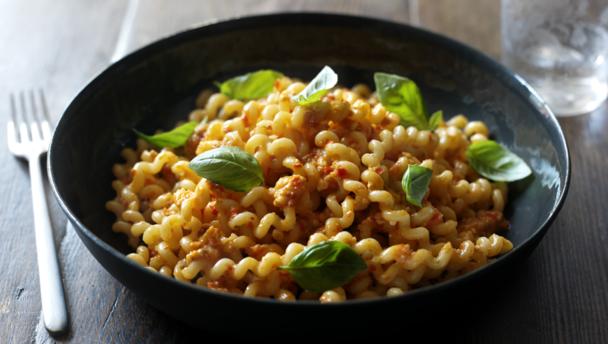

By Nigella Lawson
Quick, tasty and filling - pasta is perfect for midweek meals. We've got hundreds of delicious recipes to choose from.
See all recipes for pasta (44)
 Pepper, tomato and basil pasta
Pepper, tomato and basil pasta
 Ceps tortellini with roasted nuts and sage butter
Ceps tortellini with roasted nuts and sage butter
 Pasta with winter ratatouille
Pasta with winter ratatouille
 Tuna and sweetcorn pasta salad
Tuna and sweetcorn pasta salad
 Beef cheek and butternut broth in sourdough
Beef cheek and butternut broth in sourdough
Pasta can be fresh or dried, made of pure durum wheat, sometimes with egg, and flavoured with ingredients such as spinach, tomato, beetroot or squid ink. The shape of pasta used depends on the dish being cooked. There is pasta for soup, for serving with sauces, for baking and for stuffing.
There are hundreds of pasta shapes, each of which allows sauce to cling in different ways. A simple rule of thumb to remember is that thin and long pasta suits oily, more liquid sauces, while wider pasta and more complicated shapes (twisted, hollow or curved) are better for thicker, chunkier sauces, as there's room for them to nestle and cling to the pasta.
Although fresh pasta is often considered superior to dried, this isn't necessarily the case. They play very different roles in the kitchen and in Italy it's almost inconceivable to interchange fresh and dried pasta. Dried pasta has a firmer, denser texture when cooked and is suited to chunky, meaty or oily sauces. Fresh pasta has a softer, more absorbent texture and takes on the flavours of the sauce with which it's served. It goes well with buttery or creamy sauces or sauces with delicate flavours.
If buying fresh or dried pasta it's worth spending a bit extra on a good quality brand. There are many poorly made pastas on the market which will provide you with a disappointing, pappy texture. At the same time there are some excellent pasta-makers makers who follow traditional methods and make terrific pasta. But for guaranteed authentic pasta, make your own at home.
Dried pasta keeps its flavour for up to two years if stored well in an airtight container. Dried egg pasta made won't last as long but can still be stored for a few months - check the use-by date to be sure. Fresh pasta has to be eaten within a day or two at the most (it does freeze successfully, though won't taste as good as when eaten on the day it's made). Cooked (dried) pasta freezes well and can be kept for a couple of months. Freeze pasta sauces separately if you can, because they'll keep better (unless you've made a lasagne, which is fine to freeze whole).
For a quick meal, the variety of dried pasta available is indispensable; if you have more time, there’s nothing more rewarding than making your own pasta with a simple combination of flour and eggs. Remember the two rules passed down from Nigella's mentor Anna del Conte - when cooking pasta, use water that's as salty as the Mediterranean, and when serving it, don't drain it too thoroughly because a little water will help incorporate the sauce.
Long thin pasta is traditionally served with tomato, seafood or light vegetable sauces, while a sauce with chunks of meat is more likely to be served with wide pasta such as tagliatelle or short tube shapes such as penne.
For thin soups, tiny pasta shapes or vermicelli are good. More robust soups like minestrone take pasta like macaroni or bits of spaghetti. Ravioli and tortellini are examples of stuffed pasta and the fillings can vary from meat to cheese and vegetables like the classic ricotta and spinach.
Lasagne sheets and cannelloni sheets are good pastas to use in baked meat or vegetable dishes like lasagne al forno and cannelloni. Every store cupboard should have a pasta shape or two - the cook would be lost without it.
Whether you're using fresh or dried pasta it should always be cooked in a large pan of boiling water with salt to taste. Use about 6 litres/10 pints of water to 500g/1lb of pasta. When the pasta is completely submerged in the water on a rolling boil, stir it from time to time to make sure it isn't sticking to the bottom of the pan.
The well-known 'tip' to put olive oil in the pan to prevent the pasta from sticking isn't favoured by many chefs, because it stops the sauce clinging to the pasta when serving and is considered unnecessary. Oil does, however, help prevent the water boiling over. It's just as effective to stir the pasta occasionally to prevent it from sticking, rather than using olive oil.
For an Italian, the only way to serve pasta is cooked 'al dente' (to the bite). Taste the pasta towards the end of the cooking time; it should feel a little elastic and you should feel a little resistance in the centre of the pasta when you bite down. Drain the pasta in a colander (leaving a little water clinging to the pasta to prevent sticking) and mix with the sauce. Fresh pasta is still full of moisture, so needs far less cooking time than dried; sometimes just 30 seconds is enough (though three minutes is more standard), so read the packet instructions and keep testing it for doneness.
How much pasta you cook depends on whether the pasta is a first course or main course and how hungry you and your family or guests are! As a guide, per person you should allow 75g-115g/3oz-4oz dried pasta; 115g-150g/4oz-5oz fresh pasta; 175g-200g/6oz-7oz filled pasta, such as ravioli.
Type the ingredients you want to use, then click Go. For better results you can use quotation marks around phrases (e.g. "chicken breast"). Alternatively you can search by chef, programme, cuisine, diet, or dish (e.g. Lasagne).